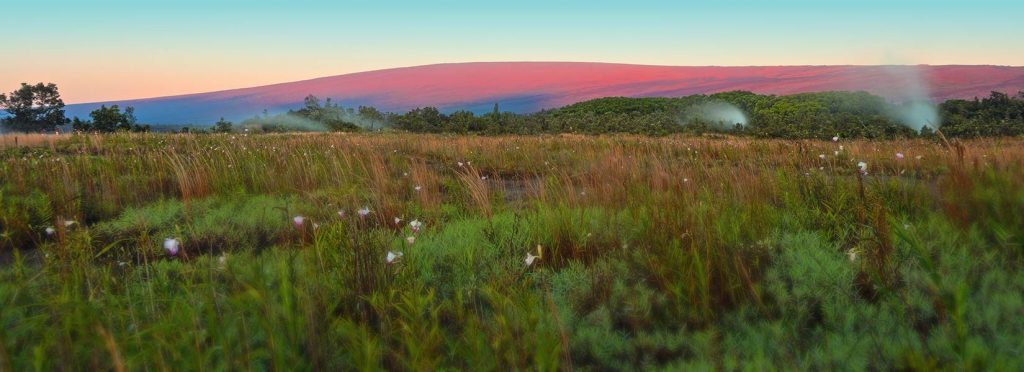When investigating Volcano, Hawaii weather for your trip, it is important to remember that you’re not looking at one climate but many differing ones. The weather in Volcano may be quite different from that in Hawai’i Volcanoes National Park, even though they’re literally right next to each other.
Weather patterns on the Big Island often come as a surprise to visitors. Everyone always imagines sun, and that is commonly the case – but we have a hurricane season, too, that brings plenty of rain. Further, the island also has a wet and a dry side.
The dry side of the island is the west, or Kona, side. The east, or Hilo side, is the wet side. It catches the trade winds and is that much more likely to have partly cloudy days with the occasional sprinkling of rain. The Big Island’s sunniest skies and beach weather can be found on the Kohala coast.

Volcano, Hawaii Weather – Rain or Shine?
Things can get particularly confusing for guests staying at Volcano Heritage Cottages, here in Volcano Village, HI.
Volcano Village is located in a rain forest that sees high sun, mist, and drizzle, partly cloudy days – the whole range. Meanwhile, just next door, Hawai’i Volcanoes National Park sees primarily sunny days, located as it is in the Ka’u desert.
Unfortunately, many online weather sites do not make this micro-climate distinction. This means that a perfectly sunny day in the park can be misreported as rainy, simply because of its proximity to the weather in the rain forest.
A good rule of thumb is to take layers and to not assume that a site proclaiming rain in Volcano does not necessarily mean rain in Hawai’i Volcanoes National Park.
Hurricane Season in Hawaii
Hawaii’s Hurricane season falls between June and November, with almost all storm activity occurring by the end of September.
The islands rarely suffers much than lots of rain and large surf during these storms. That’s all thanks to our volcanoes, whose high peaks help to break up, divert, and weaken the storm’s winds.
Sometimes a biggie does hit us just right, though. When a tropical storm or a hurricane watch is issued, businesses, national parks, and the like are closed for a short period of time. Usually just a day or two, until the storm passes. If it’s really heavy, flights may be delayed or rescheduled.
The Best Time To Visit
There is no bad time to come to Hawaii and a “best” time is dependent upon personal preferences. Maybe you’re wanting to maximize your daylight hours, or perhaps you want avoid the busy season’s crowds. Whatever the factors you seek, below are a few facts to help you decide when your best time to visit Hawaii might be! (hint: it’s really soon!)
- Driest Months: between May and October (excepting the occasional hurricane).
- Busy Season(s): There are two traditionally busy season on the Big Island. Mid-June through the end of August and between mid-December and mid-March.
- Hurricane Season: June through November with most activity occurring through September.
- Longest Days: Daylight hours stretch 2 and a half hours longer in June than they do in December.
Anytime of year is a great time for a visit to Volcano Heritage Cottages. Please explore our 4 vacation rentals that are located within 5 minutes of Hawai’i Volcanoes National Park.
